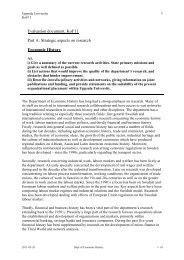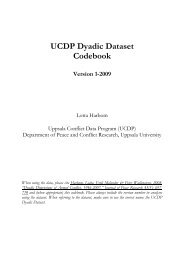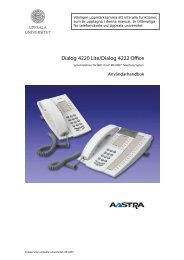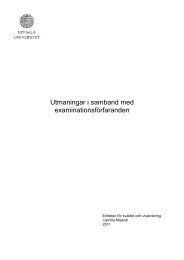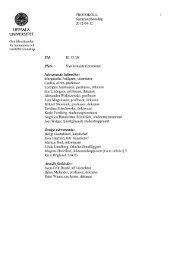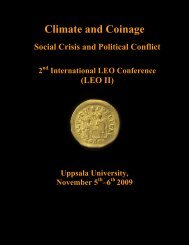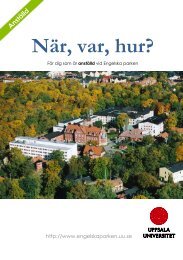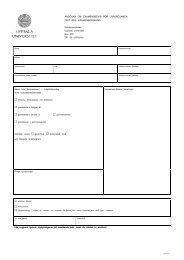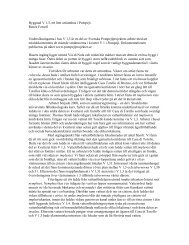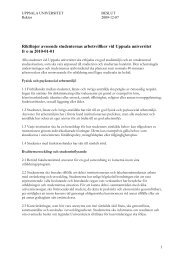Evidence for early trade between the coast and interior of east Africa
Evidence for early trade between the coast and interior of east Africa
Evidence for early trade between the coast and interior of east Africa
You also want an ePaper? Increase the reach of your titles
YUMPU automatically turns print PDFs into web optimized ePapers that Google loves.
<strong>Evidence</strong> <strong>for</strong> <strong>early</strong> <strong>trade</strong> <strong>between</strong> <strong>the</strong> <strong>coast</strong> <strong>and</strong> <strong>interior</strong> <strong>of</strong> <strong>east</strong><strong>Africa</strong>C. M. NELSONThe Jarigole ossuary complexThe Jarigole ossuary complex (Merrick, Koch & Nelson In Preparation) consists <strong>of</strong> aseries <strong>of</strong> ossuaries <strong>and</strong> related sites which ring Lake Turkana (Fig. 1). The most complex<strong>of</strong> <strong>the</strong>se sites are pillar ossuaries <strong>and</strong> include Jarigole, <strong>the</strong> Kalokol pillar site(Ng’amoritung’a II) (Lynch & Robbins 1978; Soper 1982), <strong>the</strong> Lothagam pillar site, <strong>the</strong> IlLokeridede pillar site (C. Koch, pers. comm.) <strong>and</strong> <strong>the</strong> Suguta pillar site (Robbins & Lynch1975, p. 8). The essential associations at <strong>the</strong>se sites are low mounds <strong>of</strong> gravel, usuallycontained by curbs <strong>of</strong> cobbles, <strong>and</strong> into which burials <strong>and</strong> bundles <strong>of</strong> bones <strong>and</strong> gravegoods were interred, natural columns <strong>of</strong> stone brought to <strong>the</strong> sites <strong>and</strong> erected on <strong>and</strong>adjacent to <strong>the</strong> mounds, <strong>and</strong> ceramics <strong>of</strong> Nderit ware as <strong>the</strong> principle grave goods. Thecomplex also includes very small sites which may contain internments or pits used toprepare <strong>the</strong> dead be<strong>for</strong>e <strong>the</strong>ir bones were moved to an ossuary (e.g. GbJj4 at Jarigole;Kamau 1991). These smaller sites also contain ceramics <strong>of</strong> Nderit ware.The Jarigole pillar siteOnly two <strong>of</strong> <strong>the</strong> pillar sites have been tested (<strong>for</strong> a detailed description <strong>of</strong> <strong>the</strong> Jarigole pillarsite: see Nelson Forthcoming). The evidence <strong>for</strong> <strong>early</strong> <strong>trade</strong> reported in this paper comesfrom <strong>the</strong> pillar site at Jarigole (GbJjl) <strong>and</strong> is based on a five percent sample <strong>of</strong> <strong>the</strong> centralmound (Table 1). The stratigraphic context is simple, but chaotic. After construction, <strong>the</strong>central mound, which is 15 m in diameter <strong>and</strong> one meter high, was used as a repository <strong>for</strong>interments <strong>and</strong> bundles containing bones <strong>and</strong> grave goods which were brought to <strong>the</strong>ossuary. The contents may already have been fragmentary at <strong>the</strong> time <strong>the</strong>y were buried.Repeated excavations <strong>of</strong> small pits to deposit burials <strong>and</strong> grave goods ensured that earlierpits were intruded <strong>and</strong> <strong>the</strong>ir contents scattered in <strong>the</strong> tailings <strong>and</strong> pit fillings <strong>of</strong> more recentinterments, a process which fur<strong>the</strong>r fragmented <strong>the</strong> artefacts <strong>and</strong> exposed <strong>the</strong>m on <strong>the</strong>surface <strong>for</strong> long enough periods to be destroyed by wea<strong>the</strong>ring. Sherds with evidence <strong>of</strong>prior wea<strong>the</strong>ring at <strong>the</strong> surface are common. The wea<strong>the</strong>ring histories <strong>of</strong> some individualsherds reveal as many as two whole <strong>and</strong> one half cycle <strong>of</strong> exposure <strong>and</strong> reburial (original1
laboratory as being in an advanced state <strong>of</strong> wea<strong>the</strong>ring. The apatite produced a 13 C value<strong>of</strong> -10.3, considered anomalous <strong>for</strong> uncontaminated human bone. Burial 2 contained anostrich egg shell necklace but no ceramics. It produced <strong>the</strong> date <strong>of</strong> 3125 on apatite, but<strong>the</strong> gelatin was again too poorly preserved to date (cf. Bar<strong>the</strong>lmé 1981; Bar<strong>the</strong>lmé 1985<strong>for</strong> treatment <strong>of</strong> <strong>the</strong>se dates). Bar<strong>the</strong>lmé describes <strong>the</strong> bone from this burial as highlywea<strong>the</strong>red but not as being partially fossilized. The poor condition <strong>of</strong> <strong>the</strong> bone raisesquestions about <strong>the</strong> accuracy <strong>of</strong> <strong>the</strong> date while <strong>the</strong> differences in preservation <strong>between</strong> <strong>the</strong>two burials raises a fur<strong>the</strong>r question <strong>of</strong> association since <strong>the</strong> date is not on <strong>the</strong> burialcontaining <strong>the</strong> probable Nderit pots. For <strong>the</strong>se reasons, <strong>the</strong> date should be set aside untilcorroborated.<strong>Evidence</strong> <strong>for</strong> <strong>trade</strong> with <strong>the</strong> Indian Ocean <strong>coast</strong>Strigatella paupercula has been identified by Dr. Pieter W. Kat (National Museums <strong>of</strong>Kenya) on <strong>the</strong> basis <strong>of</strong> thirteen specimens from <strong>the</strong> central mound at <strong>the</strong> Jarigole pillar site.It is a small snail common on <strong>the</strong> beaches <strong>of</strong> <strong>the</strong> Indian Ocean from South <strong>Africa</strong> to <strong>the</strong>Horn. Fresh, <strong>the</strong> shell is typically white <strong>and</strong> brownish red. Some <strong>of</strong> <strong>the</strong> specimens fromJarigole preserve this reddish pigment in narrow b<strong>and</strong>s which spiral up <strong>the</strong> body <strong>of</strong> <strong>the</strong>shell, following its whorls. The color is similar to that <strong>of</strong> many <strong>of</strong> <strong>the</strong> ceramic vessels,which were finished with mineral slips <strong>and</strong> paints that fired to various hues <strong>of</strong> red <strong>and</strong>orange. O<strong>the</strong>r specimens are wea<strong>the</strong>red until chalky at <strong>the</strong> surface. These do not preserve<strong>the</strong> pigmentation. Like <strong>the</strong> ceramics, <strong>the</strong> beads have probably been subjected to exposure<strong>and</strong> reburial, which explains <strong>the</strong>ir variable conditions.Strigatella beads were manufactured by grinding away <strong>the</strong> surface on <strong>the</strong> faceopposite <strong>the</strong> mouth <strong>of</strong> <strong>the</strong> shell in <strong>the</strong> same manner as <strong>the</strong> money cowry is prepared <strong>for</strong>sewing onto clothing (Fig. 2). Usually <strong>the</strong> ground opening is <strong>for</strong>med by a single facetparallel to <strong>the</strong> ventral face <strong>of</strong> <strong>the</strong> shell, but sometimes <strong>the</strong>re are two facets <strong>for</strong>ming <strong>the</strong>opening as if <strong>the</strong> bead were designed to be laid in <strong>the</strong> angle <strong>between</strong> two intersectingsurfaces or doubled side-to-side with a second bead. Fishermen on <strong>the</strong> <strong>coast</strong> <strong>of</strong> Kenyacommonly use Strigatella as bait <strong>and</strong> prepare <strong>the</strong>m by breaking through <strong>the</strong> back <strong>of</strong> <strong>the</strong>shell to expose <strong>the</strong> flesh within. The specimens from Jarigole are carefully ground <strong>and</strong>were probably sewn on articles <strong>of</strong> clothing, but <strong>the</strong>y could have begun <strong>the</strong>ir culturalcareers as someone’s bait be<strong>for</strong>e being turned into ornaments.Coastal <strong>trade</strong> from an <strong>interior</strong> perspective4
Strigatella paupercula is a very common shell on <strong>the</strong> <strong>east</strong> <strong>Africa</strong>n <strong>coast</strong>. Its supply isvirtually infinite when considered in economic terms. Why is it <strong>the</strong>n that a ga<strong>the</strong>ring <strong>of</strong>about 260 such beads in a 4000-year-old ossuary (containing some 200,000 objects), on<strong>the</strong> shores <strong>of</strong> Lake Turkana, is important? This question needs to be placed into a broadercontext <strong>and</strong> given <strong>the</strong> perspective <strong>of</strong> scale by contrasting <strong>the</strong> transport <strong>of</strong> Strigatellashells, which were brought some 840 kilometers from <strong>the</strong> <strong>coast</strong>, with <strong>the</strong> transport <strong>of</strong>more local items <strong>of</strong> <strong>trade</strong> or portage which occur at Jarigole. Of particular interest among<strong>the</strong>se are beads <strong>and</strong> pendants <strong>of</strong> amazonite, a gem quality <strong>for</strong>m <strong>of</strong> feldspar. These comefrom a single source which must be very small in extent <strong>and</strong> located someplace in <strong>the</strong>basement complex, most probably to <strong>the</strong> <strong>east</strong> or nor<strong>the</strong>ast. No known Kenyan sourcematches <strong>the</strong> specimens from Jarigole, but <strong>the</strong>re is an Ethiopian source which might. In anyevent, what we know <strong>of</strong> <strong>the</strong> regional geology suggests a transport distance <strong>between</strong> 150<strong>and</strong> 300 kilometers. Amazonite is about twice as abundant as Strigatella shells at Jarigole.Local raw materials <strong>of</strong> hard stone, such as agate, are abundant <strong>and</strong> widespread inalluvial sources, but beads <strong>of</strong> <strong>the</strong>se materials are less common than those <strong>of</strong> amazonite.They are also not as well finished <strong>and</strong> usually have larger per<strong>for</strong>ations, suggesting that <strong>the</strong>amazonite is being <strong>trade</strong>d mostly in <strong>the</strong> <strong>for</strong>m <strong>of</strong> finished beads ra<strong>the</strong>r than raw material.On <strong>the</strong> o<strong>the</strong>r h<strong>and</strong>, ceramics which contain no obvious volcanic temper, but large amounts<strong>of</strong> quartz derived from <strong>the</strong> basement complex, are abundant <strong>and</strong> almost certainly account<strong>for</strong> more than 1000 vessels from <strong>the</strong> ossuary as a whole. These must have been made at adistance <strong>of</strong> at l<strong>east</strong> 80 to 120 kilometers. Likewise, artefacts <strong>of</strong> obsidian, most <strong>of</strong> whichare likely to come from a mere 60 to 80 km northward, number in <strong>the</strong> thous<strong>and</strong>s.Taken toge<strong>the</strong>r, <strong>the</strong>se facts suggest that <strong>the</strong> obsidian <strong>and</strong> ceramics are coming fromwithin <strong>the</strong> territory <strong>of</strong> <strong>the</strong> kin-group(s) using <strong>the</strong> ossuary <strong>and</strong> are subject to conditions <strong>of</strong>internal <strong>trade</strong> <strong>and</strong> portage, while <strong>the</strong> amazonite <strong>and</strong> Strigatella come from outside thisterritory <strong>and</strong> are subject to conditions <strong>of</strong> external <strong>trade</strong> <strong>and</strong> portage. In <strong>the</strong>secircumstances, <strong>the</strong> low frequencies <strong>of</strong> externally procured items is suggestive <strong>of</strong> twointerpretations. First, direct long-distance <strong>trade</strong> <strong>between</strong> <strong>the</strong> <strong>coast</strong> <strong>and</strong> <strong>the</strong> Turkana basin ishighly unlikely. There should be a much higher frequency <strong>of</strong> exotic items among <strong>the</strong>artefacts from <strong>the</strong> Jarigole pillar site if such <strong>trade</strong> existed. Second, a trickle-in model <strong>of</strong>exchange without pr<strong>of</strong>essional <strong>trade</strong>rs in <strong>the</strong> <strong>interior</strong> hinterl<strong>and</strong> is sufficient to explain <strong>the</strong>material at Jarigole.Continuity <strong>of</strong> <strong>coast</strong>al <strong>trade</strong> in pastoral societies5
Nderit ware <strong>and</strong> <strong>the</strong> Jarigole ossuary complex are associated with <strong>the</strong> earliest known, fullypastoral society in <strong>east</strong>ern <strong>Africa</strong>. The design structure <strong>and</strong> production technology <strong>of</strong> itsceramics are arguably <strong>the</strong> most diverse <strong>and</strong> complex <strong>of</strong> any pastoral neolithic society in <strong>the</strong>region. The ossuaries include <strong>the</strong> largest <strong>and</strong> most labor intensive cemeteries associatedwith pastoral societies in <strong>east</strong>ern <strong>Africa</strong>.Nderit ware spreads southward along <strong>the</strong> rift <strong>and</strong> in <strong>the</strong> adjoining highl<strong>and</strong>s as farsouthward as Tanzania at an <strong>early</strong> date (Leakey 1931; Bower 1973; Nelson 1976; Bower,Nelson, Waibel & W<strong>and</strong>ibba 1977, pp. 140–1) <strong>and</strong> is probably <strong>the</strong> base-line pastoraloccupation in most parts <strong>of</strong> this central corridor. Sites with <strong>early</strong> stylistic expressions <strong>of</strong>Nderit ware are shown in Figure 1. At present, however, <strong>the</strong> only well associatedradiocarbon date from south <strong>of</strong> <strong>the</strong> Turkana basin comes from GvJm4 at Lukenya Hill.Here <strong>the</strong> lowest occurrence contains Nderit ware, found beneath a date <strong>of</strong> 3290 ± 145(GX-5348, charcoal, 13 C corrected; <strong>the</strong> uncorrected age is 3285 ± 145 bp). There is also alimiting date from Seronera <strong>of</strong> 2020 BP at SE2 (Bower 1973, p. 85). What follows <strong>the</strong>spread <strong>of</strong> Nderit ware in this entire region, including <strong>the</strong> Turkana basin, is <strong>the</strong>simplification <strong>of</strong> <strong>the</strong> material expression <strong>of</strong> <strong>the</strong> ceramic <strong>and</strong> funerary traditions. It is fair toask to what extent this apparent simplification reflects a broader simplification <strong>of</strong> social<strong>and</strong> economic organization, including participation in long-distance exchange networks.The problem <strong>of</strong> sample structures makes it almost impossible to answer thisquestion in any straight<strong>for</strong>ward or definitive way. If <strong>the</strong> makers <strong>of</strong> Nderit ware in <strong>the</strong>Turkana basin did not have ossuaries which <strong>the</strong>y packed full <strong>of</strong> material goods we wouldnot have found <strong>the</strong> <strong>early</strong> evidence <strong>for</strong> <strong>trade</strong> with <strong>the</strong> <strong>coast</strong>. Changing burial practices,which include <strong>the</strong> evident proscription first <strong>of</strong> ostrich egg shell <strong>and</strong> ceramics, <strong>and</strong> later <strong>of</strong>all ornaments as appropriate grave goods, means that we must rely almost exclusively onopen sites <strong>for</strong> <strong>the</strong> recovery <strong>of</strong> <strong>trade</strong>d shells. In this context, both locally made <strong>and</strong> <strong>trade</strong>dornaments are very uncommon.Never<strong>the</strong>less, some interesting points can be made. The one complex cemetery inwhich grave goods are abundant is Njoro River Cave (Leakey & Leakey 1950), dating to3000 BP (Merrick & Monaghan 1984). Although stone beads were relatively commonhere, ostrich egg shell beads <strong>and</strong> shell beads <strong>of</strong> <strong>coast</strong>al origin are not present. It isinteresting, however, that <strong>the</strong> stone beads include one amazonite specimen which isvisually identical to <strong>the</strong> specimens from Jarigole, indicating a sou<strong>the</strong>rn extension <strong>of</strong> <strong>the</strong>exchange network in operation in <strong>the</strong> Jarigole region some centuries earlier.Although no direct evidence <strong>of</strong> <strong>coast</strong>al <strong>trade</strong> in <strong>the</strong> <strong>interior</strong> is reported in <strong>the</strong>literature, <strong>the</strong>re are a few fragments <strong>of</strong> pendants made from marine shells from <strong>the</strong> centralash deposit at Vaave Makongo (GvJm48) on Lukenya Hill, just <strong>east</strong> <strong>of</strong> Nairobi (Nelson6
1976). This is a pastoral neolithic occurrence with a date on <strong>the</strong> central ash heap <strong>of</strong> 1810 ±135 bp (GX-5347G) on bone gelatin. In addition, obsidian was transported widely <strong>and</strong> ingreat quantities during <strong>the</strong> pastoral neolithic period. Raw material from <strong>the</strong> Naivasha basinin <strong>the</strong> Central Rift valley is found as far <strong>east</strong> as Kilungu (Merrick & Brown 1984), south<strong>of</strong> Machakos, <strong>and</strong> <strong>the</strong> foothills <strong>of</strong> Mount Kilimanjaro (Mturi 1986). These localities areabout 400 kilometers from <strong>the</strong> <strong>coast</strong> <strong>and</strong> range from 140 to 250 kilometers from <strong>the</strong>obsidian sources, <strong>and</strong> well <strong>east</strong> <strong>of</strong> Lukenya Hill, where <strong>the</strong> pendent fragments <strong>of</strong> marineshell are associated with abundant obsidian debris <strong>and</strong> tools. On <strong>the</strong> <strong>east</strong> side <strong>of</strong> <strong>the</strong> Rift,overlap in <strong>the</strong> distribution <strong>of</strong> <strong>coast</strong>al shells <strong>and</strong> obsidian from <strong>the</strong> Central Rift shows that<strong>the</strong> exchange network extended from <strong>the</strong> Rift to <strong>the</strong> <strong>coast</strong>. On <strong>the</strong> west side <strong>of</strong> <strong>the</strong> Rift,obsidian from <strong>the</strong> same sources was transported n<strong>early</strong> to <strong>the</strong> shores <strong>of</strong> Lake Victoria, adistance <strong>of</strong> 170 kilometers (Robertshaw 1990). Thus, it is likely that <strong>the</strong> exchangenetwork extended all <strong>the</strong> way from <strong>the</strong> <strong>coast</strong> to Lake Victoria.Although <strong>the</strong> evidence is scanty, it is clear that, once established, pastoralexchange networks endured <strong>and</strong> were available <strong>for</strong> development as trading ports emergedalong <strong>the</strong> <strong>coast</strong> <strong>of</strong> <strong>east</strong>ern <strong>Africa</strong>. However, a great deal more work needs to be done todetermine to what extent, <strong>and</strong> how <strong>early</strong>, such pastoral networks were actually used.Interior <strong>trade</strong> from a <strong>coast</strong>al perspectiveThe <strong>trade</strong> <strong>of</strong> shells from <strong>the</strong> <strong>coast</strong> <strong>of</strong> <strong>east</strong> <strong>Africa</strong> to far <strong>of</strong>f Jarigole, however modest, isnever<strong>the</strong>less quite significant. It demonstrates that <strong>the</strong>re was an extensive trading networkin existence be<strong>for</strong>e <strong>the</strong> rise <strong>of</strong> <strong>coast</strong>al trading ports or <strong>the</strong> involvement <strong>of</strong> <strong>interior</strong>-derivedcommodities in an international system <strong>of</strong> <strong>trade</strong> <strong>between</strong> states. This pre-existing tradingnetwork is likely to have been <strong>the</strong> basis <strong>for</strong> <strong>the</strong> <strong>early</strong> stages <strong>of</strong> larger-scale <strong>coast</strong>al/<strong>interior</strong><strong>trade</strong>.More interesting still is <strong>the</strong> fact that pastoralists were involved in extensive tradingnetworks from <strong>the</strong>ir earliest well documented penetration into <strong>east</strong>ern <strong>Africa</strong>. Pastoralpeoples maintain large territories within which <strong>the</strong>y are highly mobile <strong>and</strong> <strong>the</strong>y maintainfar-flung contacts to facilitate <strong>the</strong> movement <strong>and</strong> pasturage <strong>of</strong> stock during times <strong>of</strong>drought. This also places <strong>the</strong>m in a position to facilitate <strong>trade</strong> in ways which hunters <strong>and</strong>ga<strong>the</strong>rers or hill-bound agriculturists not are able to. Among <strong>the</strong>se are armed escorts,locally supplied b<strong>east</strong>s <strong>of</strong> burden, <strong>and</strong> safe passage <strong>for</strong> considerable distances. By 2000years ago, pastoral communities dominated <strong>the</strong> l<strong>and</strong>scape from Kilimanjaro to LakeVictoria <strong>and</strong> from Lake Eyasi to <strong>the</strong> Ethiopian highl<strong>and</strong>s, a vast potential market alreadyaccessible through established exchange networks.7
AcknowledgementsI would like to thank <strong>the</strong> Koobi Fora Field School <strong>of</strong> Palaeoanthropology <strong>and</strong> Archaeology <strong>for</strong> supporting<strong>the</strong> excavation <strong>and</strong> survey work on which this paper is based, <strong>and</strong> <strong>the</strong> Fulbright Exchange Program <strong>for</strong>supporting my presentation to <strong>the</strong> conference <strong>and</strong> <strong>the</strong> comparative research necessary <strong>for</strong> <strong>the</strong> preparation<strong>of</strong> <strong>the</strong> manuscript.ReferencesBar<strong>the</strong>lmé, J. W. 1981. Late pleistocene-holocene prehistory to <strong>the</strong> nor<strong>the</strong>ast <strong>of</strong>Lake Turkana, Kenya. Unpublished PhD <strong>the</strong>sis, University <strong>of</strong> Cali<strong>for</strong>nia inBerkeley.Bar<strong>the</strong>lmé, J. W. 1984. Early evidence <strong>for</strong> animal domestication in <strong>east</strong>ern <strong>Africa</strong>. InFrom Hunters to Farmers: <strong>the</strong> causes <strong>and</strong> consequences <strong>of</strong> food production in<strong>Africa</strong>, Clark, J. D. & S. A. Br<strong>and</strong>t (eds), 200–3. Berkeley: University <strong>of</strong>Cali<strong>for</strong>nia Press.Bar<strong>the</strong>lmé, J. W. 1985. Fisher-hunters <strong>and</strong> neolithic Pastoralists in East Turkana,Kenya. Ox<strong>for</strong>d: British Archaeological Reports.Bower, J. R. F. 1973. Seronera: excavations at a stone bowl site in <strong>the</strong> SerengetiNational Park, Tanzania. Azania 8, 71–104.Bower, J. R. F., C. M. Nelson, A. F. Waibel & S. W<strong>and</strong>ibba 1977. The University <strong>of</strong>Massachusetts’ later stone age/pastoral neolithic comparative study in centralKenya: an overview. Azania 12, 119–46.Kamau, J. 1991. Report on a ‘Stone pillar’ site nor<strong>the</strong>ast <strong>of</strong> Jarigole Burial Mound,East Turkana. Nyama Akuma 36, 6–8.Leakey, L. S. B. 1931. The Stone Age Cultures <strong>of</strong> Kenya Colony. Cambridge:Cambridge University Press.Leakey, M. D. & L. S. B. Leakey 1950. Excavations at <strong>the</strong> Njoro River Cave.Ox<strong>for</strong>d: Clarendon Press.8
Lynch, B. M. & L. Robbins 1978. Namoratunga: <strong>the</strong> first archaeo-astronomicalevidence in sub-Saharan <strong>Africa</strong>. Science 200, 766–8.Merrick, H. V. M. & F. Brown 1984. Obsidian sources <strong>and</strong> patterns <strong>of</strong> sourceutilization in Kenya <strong>and</strong> nor<strong>the</strong>rn Tanzania: some initial findings. <strong>Africa</strong>nArchaeological Review 2, 129–52.Merrick, H. V. M., C. Koch & C. M. Nelson In Preparation. The Jarigole ossuarycomplex.Merrick, H. V. M. & M. L. Monaghan 1984. The date <strong>of</strong> <strong>the</strong> cremated burials inNjoro River Cave. Azania 19, 7–12.Mturi, A. A. 1986. The pastoral neolithic <strong>of</strong> West Kilimanjaro. Azania 21, 53–64.Nelson, C. M. 1976. Results <strong>of</strong> salvage archaeology at Lukenya Hill, near Nairobi,Kenya. Unpublished report, National Museums <strong>of</strong> Kenya, Nairobi.Nelson, C. M. Forthcoming. The work <strong>of</strong> <strong>the</strong> Koobi Fora Field School at <strong>the</strong>Jarigole pillar sites, Lake Turkana, Kenya. Kenya Past <strong>and</strong> Present 27.Robbins, L. H. 1972. Archaeology in <strong>the</strong> Turkana District, Kenya. Science 176,359–66.Robbins, L. H. & B. M. Lynch 1975. Prehistory <strong>and</strong> Paleoenvironment in <strong>the</strong> LakeTurkana Basin: final report on archaeological fieldwork carried out in TurkanaDistrict, Kenya. Nairobi: National Museums <strong>of</strong> Kenya <strong>and</strong> <strong>the</strong> National ScienceFoundation.Robertshaw, P. T. 1990. The Early Pastoralists <strong>of</strong> Southwestern Kenya. Nairobi:British Institute in Eastern <strong>Africa</strong>.Soper, R. 1982. Archaeo-astronomical Cushites: some comments. Azania 17, 145–62.9
Table 1. Contents <strong>of</strong> <strong>the</strong> mound at <strong>the</strong> Jarigole pillarsite (GbJj1).Items in bold have been transported more than 60kilometers.DescriptionSample Projected SourceFigurines 12 200 Mostly localCeramic vessels <strong>of</strong>Nderit ware>650 >13,000Ostrich egg shell vessels 6 120 LocalOstrich egg shell beads 6200 120 000 LocalIvory beads & ornamentfragments19 380 LocalAbout 40 % made outside <strong>the</strong>volcanic areaPossibly tortoiseIvory-like mystery beads 7 140toesBone beads & ornaments 11 220 LocalBeads <strong>of</strong> StrigatellapauperculaO<strong>the</strong>r shell beads &ornamentsAmazonite beads &pendantsO<strong>the</strong>r basementcomplex beadsFrom <strong>the</strong> <strong>coast</strong> <strong>of</strong> <strong>the</strong> Indian13 260Ocean10 200 LocalCarnelian beads 2 40 LocalAgate beads 3 60 LocalCalcite beads 19 380 LocalS<strong>of</strong>t stone beads(includes Fluorite)30Not local, possibly from sou<strong>the</strong>rn600Ethiopia11From outside <strong>the</strong> volcanic area <strong>of</strong>220<strong>the</strong> basin41 820 Origin uncertain3 <strong>of</strong> <strong>the</strong>se included in beadPhallic ornaments 5 100categories aboveSmall stone spheres 3 60 Local?Polished pebbles <strong>of</strong>quartzFrom outside <strong>the</strong> volcanic area <strong>of</strong>11 220<strong>the</strong> basinPorphyry pebbles 2 40 Origin uncertainPestle rubbers (<strong>for</strong>ochre?)Large palette 1 20 LocalSmall whet stones 6 120 LocalFlaked basalt 725 14 000 LocalFlaked silica 170 3400 LocalFrom outside <strong>the</strong> volcanic area <strong>of</strong>2 40<strong>the</strong> basinFrom outside <strong>the</strong> volcanic area <strong>of</strong>Flaked vein quartz 7 140<strong>the</strong> basinFlaked obsidian 2240 44 800Nearest source about 80km
Table 1. Contents <strong>of</strong> <strong>the</strong> mound at <strong>the</strong> Jarigole pillarsite (GbJj1).Items in bold have been transported more than 60kilometers.DescriptionSample Projected SourceFigurines 12 200 Mostly localCeramic vessels <strong>of</strong>Nderit ware>650 >13,000Ostrich egg shell vessels 6 120 LocalOstrich egg shell beads 6200 120 000 LocalIvory beads & ornamentfragments19 380 LocalAbout 40 % made outside <strong>the</strong>volcanic areaPossibly tortoiseIvory-like mystery beads 7 140toesBone beads & ornaments 11 220 LocalBeads <strong>of</strong> StrigatellapauperculaO<strong>the</strong>r shell beads &ornamentsAmazonite beads &pendantsO<strong>the</strong>r basementcomplex beadsFrom <strong>the</strong> <strong>coast</strong> <strong>of</strong> <strong>the</strong> Indian13 260Ocean10 200 LocalCarnelian beads 2 40 LocalAgate beads 3 60 LocalCalcite beads 19 380 LocalS<strong>of</strong>t stone beads(includes Fluorite)30Not local, possibly from sou<strong>the</strong>rn600Ethiopia11From outside <strong>the</strong> volcanic area <strong>of</strong>220<strong>the</strong> basin41 820 Origin uncertain3 <strong>of</strong> <strong>the</strong>se included in beadPhallic ornaments 5 100categories aboveSmall stone spheres 3 60 Local?Polished pebbles <strong>of</strong>quartzFrom outside <strong>the</strong> volcanic area <strong>of</strong>11 220<strong>the</strong> basinPorphyry pebbles 2 40 Origin uncertainPestle rubbers (<strong>for</strong>ochre?)Large palette 1 20 LocalSmall whet stones 6 120 LocalFlaked basalt 725 14 000 LocalFlaked silica 170 3400 LocalFrom outside <strong>the</strong> volcanic area <strong>of</strong>2 40<strong>the</strong> basinFrom outside <strong>the</strong> volcanic area <strong>of</strong>Flaked vein quartz 7 140<strong>the</strong> basinFlaked obsidian 2240 44 800Nearest source about 80km



